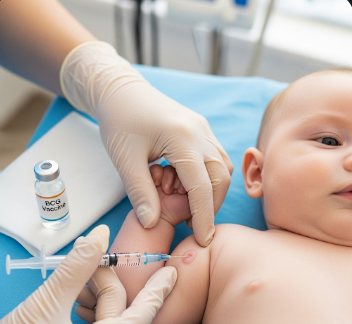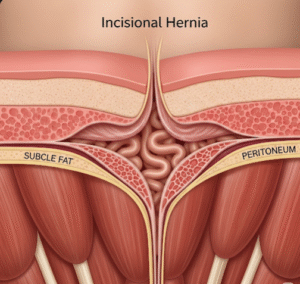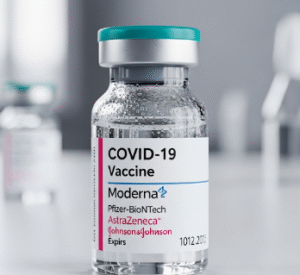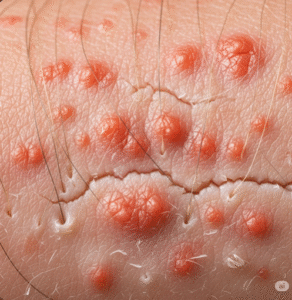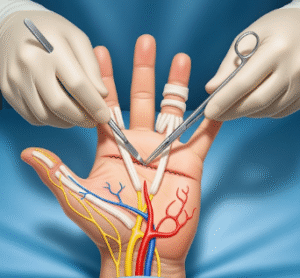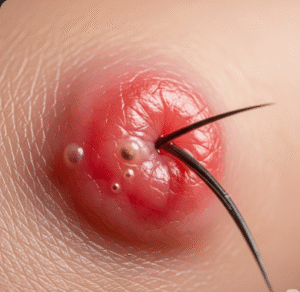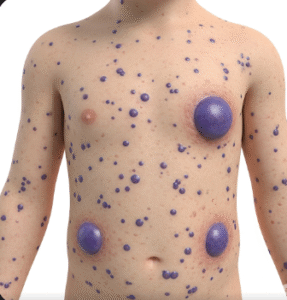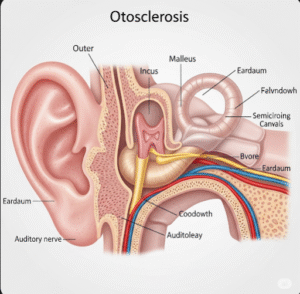Overview
The BCG (Bacillus Calmette–Guérin) vaccine is a live attenuated vaccine primarily used to protect against tuberculosis (TB), a contagious bacterial infection caused by Mycobacterium tuberculosis. TB mainly affects the lungs but can also impact other organs, leading to pulmonary or extrapulmonary TB.
BCG is one of the oldest vaccines still in use, developed in the early 20th century, and is widely administered in countries with high TB prevalence, including South Korea. The vaccine is usually given once in infancy, but booster doses may be considered in specific circumstances.
Key benefits of the BCG vaccine:
- Protects infants and young children against severe forms of TB, such as TB meningitis and miliary TB.
- Reduces the risk of TB infection spreading in high-prevalence areas.
- Plays a role in public health TB control programs worldwide.
In South Korea, BCG vaccination is part of the national immunization schedule, typically administered in the first few weeks of life, either via intradermal injection or percutaneous route.
Why It’s Done
The BCG vaccine is given to prevent tuberculosis, particularly in high-risk populations and children.
Primary reasons include:
- ➤ Protection against severe TB in children, including TB meningitis and miliary TB.
- ➤ Reducing TB transmission in areas with significant prevalence.
- ➤ Part of national immunization programs to achieve community-level protection.
- ➤ Occupational or travel risk: For healthcare workers, laboratory personnel, or travelers to high TB regions.
Important highlights:
- ✔️ BCG is not fully protective against pulmonary TB in adults, but it significantly reduces severe childhood TB.
- ✔️ Helps decrease TB-related morbidity and mortality in endemic areas.
Alternatives
While BCG remains the primary preventive measure in many countries, there are alternative or complementary strategies for TB prevention:
- ➤ TB screening and prophylactic treatment:
- Latent TB infection (LTBI) can be detected with tuberculin skin test (TST) or IGRA blood test.
- Preventive therapy with isoniazid or rifampicin may be prescribed for high-risk individuals.
- ➤ Infection control measures:
- Use of masks, ventilation, and isolation in healthcare settings.
- Public health measures for early detection and treatment of active TB cases.
- ➤ Future vaccines:
- Multiple TB vaccine candidates are under development, including subunit, viral vector, and recombinant vaccines, aiming to provide better protection for adolescents and adults.
Key point: While alternatives focus on preventing infection or progression, BCG remains the only widely available vaccine against TB.
Preparation
BCG vaccination requires minimal preparation but should be approached carefully:
Preparation steps include:
- ✅ Medical history: Screening for immune deficiencies, HIV, or previous TB exposure.
- ✅ Assessment of contraindications:
- Immunocompromised individuals or those on immunosuppressive therapy.
- Severe allergic reactions to previous vaccines.
- ✅ Fasting: Not required; BCG can be given regardless of meals.
- ✅ Informing parents: For infant vaccination, parents should understand possible side effects and follow-up.
- ✅ Vaccination site preparation: Usually upper arm (intradermal) or skin surface of the arm (percutaneous).
Important: BCG vaccination should be delayed or avoided in immunocompromised infants.
How It’s Done
BCG vaccination is quick and minimally invasive. The method depends on the route:
1. Intradermal Injection (Most Common)
- Small volume (0.05 mL for infants, 0.1 mL for older children/adults) is injected into the skin of the upper arm.
- Produces a small raised wheal at the injection site.
- Typically performed with a fine needle and syringe.
2. Percutaneous (Multipuncture) Method
- BCG is applied using a multiple-prick device onto the skin.
- Creates multiple tiny punctures, allowing absorption of the vaccine.
- Less common than intradermal injection.
Immediate post-vaccine observations:
- Redness, swelling, or small blister may form at the site.
- Usually resolves over a few weeks, sometimes leaving a small scar, which is considered normal.
Duration: The procedure takes only a few minutes.
Hospital stay: Usually outpatient, with no hospitalization required.
Recovery & Follow-up
BCG vaccination has a short recovery period, with most reactions being minor and self-limiting.
Normal post-vaccine response:
- Small raised bump at the site within 2–3 weeks.
- Ulceration may occur and heal over 6–12 weeks, leaving a scar.
- Mild fever or fussiness in infants is possible.
Follow-up care:
- Keep the injection site clean and dry.
- Do not scratch or pick at the site.
- Monitor for rare adverse reactions: excessive swelling, pus formation, or persistent fever.
- Follow-up with healthcare provider if complications or doubts arise.
Long-term: BCG provides partial immunity against TB, especially severe forms in children.
Possible Complications
While generally safe, BCG vaccination can cause minor to moderate reactions:
- ⚠️ Local reactions: Redness, swelling, small ulcer, or scarring.
- ⚠️ Lymphadenitis: Swelling of nearby lymph nodes, usually mild.
- ⚠️ Allergic reactions: Rare, including rash or mild fever.
- ⚠️ Disseminated BCG infection: Extremely rare; occurs in severely immunocompromised individuals.
- ⚠️ Keloid formation: Rare, but possible at the injection site.
Important: Serious complications are rare in healthy infants and children. Korean vaccination programs follow strict screening and monitoring protocols to ensure safety.
Treatment Options in Korea
South Korea has a robust national immunization program, providing BCG vaccination to infants as part of public health initiatives.
Key features:
- 🏥 Early infant vaccination: Administered within the first few weeks of life.
- 🏥 Multiple delivery methods: Intradermal (preferred) and percutaneous options available.
- 🏥 High safety standards: Vaccines produced under strict quality control.
- 🏥 Monitoring and follow-up: National health centers track vaccination status and adverse reactions.
- 🏥 Public health integration: Combined with TB screening, preventive therapy, and public awareness campaigns.
Hospitals and vaccination centers in Korea:
- Seoul National University Hospital – pediatric immunization services
- Samsung Medical Center – BCG and childhood vaccines
- Asan Medical Center – comprehensive vaccination and TB prevention programs
- Local public health centers – BCG vaccination and follow-up
Highlights of BCG in Korea:
- ✔️ Protects children against severe TB forms.
- ✔️ Part of national TB prevention strategies.
- ✔️ Administered by trained medical professionals with strict adherence to guidelines.
Highlights
- ➤ BCG vaccine is the primary preventive tool against TB, especially in children.
- ➤ Administered intradermally or percutaneously, usually in infancy.
- ➤ Reduces risk of TB meningitis and miliary TB in children.
- ➤ Mild post-vaccine reactions are normal, including redness, swelling, or scarring.
- ➤ Severe complications are extremely rare, mainly in immunocompromised individuals.
- ➤ South Korea offers BCG as part of a national immunization program, with high safety standards and expert medical supervision.
- ➤ Integration with TB screening and public health programs ensures comprehensive protection.

